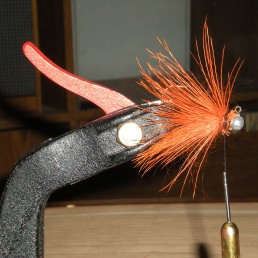Tying Jigs: A Worthwhile Winter Project
SHARE THIS POST
Winter can be a tough season if you don’t ice fish. A lot of open-water fishermen often wonder about what’s taking place under the sheet of ice. And a mental replay of tail-walking smallmouths caught last summer and fall can bring a pang to our hearts.
Keeping busy during this time of the year can be a chore. But you can do things to help with the anxiety. Making jigs is one way to be productive. And making baits to catch smallmouths can help quell the mental storm.
I specifically like using bucktail, more commonly referred to as deer hair. It’s a good place to start. And it can be easy to make.
While the jig-making process can entail molten lead, you can avoid the molding process and get straight to tying them. Just buy some pre-molded heads in 1/16- through 1/4-ounce weights. If they are already painted, I would stay with black as a color. Virtually any place that sells fishing equipment should have a variety.
Other tools include a bobbin, a threader to get the thread through the bobbin, thread, glue, a vise, a scissors and deer hair. You don’t need a bunch of colors. Most of my fishable ones are black and natural color. You can vary the hair color as much as you wish. You should be able to get all of these through a source like Barlow’s Tackle lure making catalog, or their online location. Once you have the stuff, you can tie some jigs up anytime you need more baits.
Start by putting the jig head in the vise, hook up. Use a drop of glue (Super Glue works) on the jig collar and secure it with a few wraps of thread. Cut the deer hair and feather it over the collar. Then add another drop of glue and wind to hold it. Turn the jig over in the vise. Then cut another piece of bucktail and feather it over the jig. Make sure it is spread evenly. Then apply more thread to finish the job. Add more glue on the wrap and secure the hair with a half hitch and snip the thread just above it. Once dry, it should be ready to go. When you get the hang of it, it gets easier.
Are you enjoying this post?
You can be among the first to get the latest info on where to go, what to use and how to use it!
One nice thing about deer hair is that it is hollow. That makes it sink slower and gives the smallmouths an opportunity to zero in on the bait. Putting scent on it works well, as the scent can work its way into the hair and help cover up any human odor imparted to the jig as you tie it on your line.
As you tie, you use more pressure or less, as needed. Less pressure on the thread gives you a normal jig. You can also add more pressure, which flares the hair out and makes it sink slower. The suggested thread sold is fairly strong, but always be careful so you do not break it.
I use a small, fire tail worm on the back of my jigs. I begin with a 4-inch worm and maybe clip another inch or so off. You can also use twister tails or other plastics. As far as fishing it, you can jig it, drag it or swim it. The closer to bottom you fish it, the better it works.
Once you get the knack of tying jigs, there are a lot of other materials you can work with. At some point, you’ll know if you want to actually mold and make your own heads. If you do, you can get hooks, a melting pot and lead and go from there. Barlow’s has these, too.
For more insight and tips for fishing throughout the year, check out the articles in every issue of MidWest Outdoors, available by subscribing on our website.
MWO
SHARE THIS POST
You may also like...
Nothing found.
Did you enjoy this post?
You can be among the first to get the latest info on where to go, what to use and how to use it!
Tom Luba
Tom Luba is a freelance outdoor writer living in New London, Wis. He has written about open water fishing for more than 35 years.
